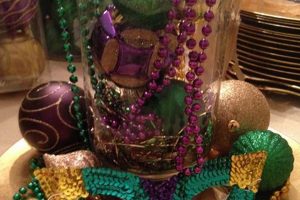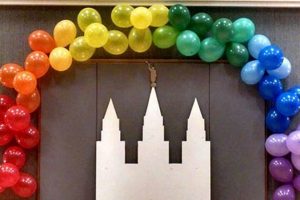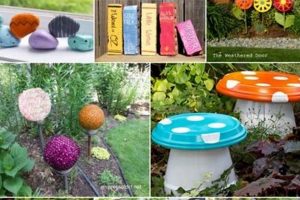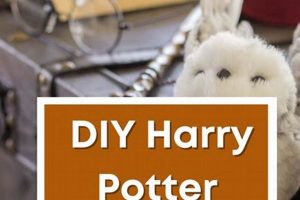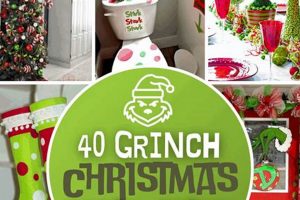The practice of creating festive embellishments inspired by the whimsical world of Dr. Seuss’s Whoville allows individuals to personalize holiday celebrations. These handcrafted items, ranging from misshapen ornaments to creatively repurposed household objects, evoke the distinctive aesthetic of the fictional town. For example, crafting lopsided Christmas trees from felt or cardboard, or building miniature Whoville houses from shoeboxes, exemplifies this approach.
The appeal of such projects lies in their affordability, personalization potential, and inherent charm. Utilizing recycled materials and simple techniques makes festive decorating accessible to a wider audience. Furthermore, these creations often become cherished keepsakes, adding a unique and memorable element to holiday traditions. The spirit of resourcefulness and imagination aligns with the themes of community and goodwill often associated with the holiday season.
The following sections will explore specific project ideas, material recommendations, and step-by-step instructions for crafting these unique and engaging holiday accents. Techniques for achieving the characteristic visual style, including color palettes and structural designs, will be discussed in detail.
Tips for Whoville-Inspired Crafting
Achieving an authentic Whoville aesthetic in crafted decorations requires attention to detail and an understanding of the source material’s distinctive visual language. The following guidelines offer practical advice for successful execution.
Tip 1: Embrace Imperfection: Whoville’s charm lies in its whimsical asymmetry. Intentional irregularities in shape and proportion are crucial. Avoid striving for perfect symmetry or flawless execution.
Tip 2: Utilize a Vibrant Color Palette: Incorporate a range of bright, non-traditional holiday colors. Pinks, purples, teals, and oranges, in addition to classic reds and greens, capture the playful spirit of Whoville. Consider unexpected color combinations.
Tip 3: Repurpose and Recycle Materials: Emphasize resourcefulness by using repurposed household items. Cardboard boxes, plastic bottles, and fabric scraps can be transformed into Whoville-esque structures and ornaments.
Tip 4: Focus on Exaggerated Shapes: Replicate the characteristic curves and elongated forms seen in Dr. Seuss’s illustrations. Trees should be tall and spindly, houses should have rounded roofs, and ornaments should be disproportionately sized.
Tip 5: Incorporate Textural Elements: Add visual interest by incorporating various textures. Felt, yarn, and glitter can enhance the tactile appeal of crafted decorations. Consider adding pom-poms, pipe cleaners, or other embellishments.
Tip 6: Consider Scale and Perspective: When creating miniature Whoville scenes, pay attention to scale. Exaggerate the size differences between objects to create a sense of depth and perspective. Smaller items should be significantly smaller than larger items.
Tip 7: Emphasize Handcrafted Details: Hand-painted elements and hand-sewn accents contribute to the authenticity of the decorations. Avoid relying solely on mass-produced materials or techniques.
Adhering to these guidelines ensures crafted decorations effectively capture the unique visual identity and whimsical spirit associated with Whoville. The result is a personalized and memorable holiday display.
The following sections will explore specific project ideas, material recommendations, and step-by-step instructions for crafting these unique and engaging holiday accents.
1. Whimsical asymmetry
The concept of whimsical asymmetry is fundamental to successful execution of handcrafted Whoville-inspired decorations. This principle dictates a departure from conventional symmetry and rigid geometric forms, mirroring the unique visual style established in Dr. Seuss’s illustrations. The intentional introduction of imbalance and irregularity serves to capture the essence of the fictional town’s architectural and decorative motifs. Failure to embrace asymmetry results in decorations that, while potentially festive, lack the distinctive character of Whoville.
Asymmetrical elements can be implemented across a range of decorative projects. For example, crafting a Whoville-inspired Christmas tree involves deliberately creating a lopsided silhouette, rather than a perfectly conical shape. Similarly, constructing miniature Whoville houses necessitates incorporating slanted roofs, uneven window placements, and disproportionate sizes. These deliberate imperfections are not flaws, but rather essential components of the intended aesthetic. The placement of ornaments on a Whoville tree should also reflect this principle, avoiding uniform spacing or symmetrical arrangements. Real-world examples are readily found in online craft communities, where artisans showcase their interpretations of Whoville, consistently highlighting the importance of intentionally asymmetrical forms. The effectiveness of these interpretations is directly correlated with their adherence to this principle.
Understanding and implementing whimsical asymmetry is therefore crucial for anyone undertaking Whoville-themed crafting. It requires a conscious decision to deviate from traditional notions of aesthetic perfection. The challenges lie in overcoming ingrained habits of striving for symmetry. However, mastering this principle unlocks the potential to create decorations that are not merely visually appealing, but also authentically reflective of the source material, contributing significantly to the overall whimsical and playful atmosphere. Asymmetry and irregular shapes are necessary for authenticity.
2. Vibrant color palette
A vibrant color palette serves as a critical component in executing aesthetically accurate creations inspired by Whoville. The visual identity of Dr. Seuss’s Whoville deviates substantially from traditional holiday color schemes, emphasizing a spectrum of unconventional hues. This deviation directly impacts the perceived authenticity and success of Whoville-themed decorations. A muted or conventionally themed color palette diminishes the characteristic whimsical nature. For instance, using pastel blues and whites instead of the signature teals, pinks, and oranges would fail to capture the intended visual effect. The absence of vibrant color choices directly diminishes the visual impact and deviates from the defining characteristics of Whoville.
The application of a vibrant color palette extends beyond selecting the correct hues. It encompasses the strategic combination and distribution of these colors within the decorative piece. Contrasting colors can accentuate shapes and create visual interest, while analogous colors can provide a sense of harmony and cohesion. For example, a Whoville-inspired tree might incorporate alternating stripes of hot pink and lime green, contrasted with purple and teal ornaments. Likewise, miniature Whoville houses benefit from brightly colored roofs and walls, possibly employing different colors for each individual structure within a larger display. Numerous online resources and craft guides demonstrate effective combinations of these vibrant colors in various contexts, solidifying their importance in achieving the intended aesthetic. Moreover, successful implementations often involve unexpected color pairings, further emphasizing the departure from conventional holiday norms and reinforcing the unique visual identity of Whoville-themed decorations.
In conclusion, a vibrant color palette is not merely an aesthetic choice in creating Whoville decorations, but rather a foundational element essential for capturing the source material’s defining characteristic. Understanding the role and application of these colors is paramount. The challenge lies in confidently embracing non-traditional color combinations and avoiding the tendency to revert to conventional holiday schemes. Mastery of this element significantly elevates the authenticity and visual impact of any Whoville-inspired creation, directly contributing to the overall success of the project. The strategic implementation of vibrant colors successfully conveys the whimsy and non-traditional nature of the fictional setting.
3. Repurposed materials
The integration of repurposed materials into handcrafted Whoville-themed holiday embellishments aligns with both the aesthetic spirit and practical considerations of the craft. It represents a sustainable and cost-effective approach to realizing these decorations, while simultaneously enhancing their unique visual character.
- Cost Reduction
Utilizing materials already available mitigates expenses associated with purchasing new crafting supplies. Common household items, such as cardboard boxes, plastic bottles, and fabric scraps, can be transformed into components for Whoville-inspired decorations. This approach reduces the financial burden of crafting, making it accessible to a wider range of individuals.
- Unique Aesthetic Character
Repurposed materials inherently possess a distinct character shaped by their previous use. The incorporation of these materials into handcrafted decorations adds a layer of visual interest and authenticity. For instance, using weathered cardboard to construct miniature Whoville houses imparts a sense of age and imperfection, which aligns with the whimsical and slightly dilapidated aesthetic of the fictional town.
- Environmental Sustainability
The repurposing of materials directly contributes to environmental sustainability by reducing waste and minimizing the demand for new resources. This approach aligns with growing awareness of ecological issues and provides an opportunity to create festive decorations in an environmentally responsible manner. Using recycled materials effectively reduces reliance on newly manufactured products.
- Enhanced Creativity
Working with repurposed materials necessitates creative problem-solving and encourages innovative approaches to design. Constraints imposed by the available materials can stimulate unique solutions and result in decorations that are both distinctive and visually engaging. Transforming everyday objects into something new often requires inventive thinking and skillful adaptation.
The strategic implementation of repurposed materials not only supports the creation of affordable and visually engaging Whoville-themed decorations, but also promotes sustainability and enhances the overall creative process. This multifaceted approach strengthens the connection between resourcefulness and the whimsical aesthetic characteristic of these festive creations.
4. Exaggerated shapes
The incorporation of exaggerated shapes is a defining characteristic of Whoville-inspired decorations and a critical factor in accurately replicating the whimsical aesthetic found in Dr. Seuss’s illustrations. The purposeful distortion of form distinguishes these decorations from more conventional holiday designs, contributing significantly to their unique visual appeal.
- Vertical Exaggeration in Structures
Whoville architecture often features buildings that are significantly taller and narrower than typical structures. This vertical exaggeration can be replicated by crafting houses with disproportionately high roofs or trees that are excessively slender and elongated. The implementation of vertical exaggeration results in a visually distinctive and somewhat unstable appearance, characteristic of the Whoville aesthetic.
- Curvilinear Distortions
Straight lines are largely absent in Whoville’s visual landscape. Instead, shapes are defined by curves, bends, and distortions. Crafting decorations that incorporate these curvilinear elements, such as ornaments with asymmetrical bulges or signs with wavy edges, contributes to the overall whimsicality of the design. This deliberate distortion of lines and shapes enhances the perceived sense of unreality.
- Disproportionate Ornamentation
The size and placement of decorative elements are frequently exaggerated in Whoville. Ornaments might be excessively large relative to the size of the tree, or individual features on a character might be dramatically oversized. This deliberate disproportionality creates a sense of visual imbalance and contributes to the overall playful and somewhat absurd nature of the Whoville aesthetic.
- Gravity-Defying Forms
Whoville often features shapes that defy conventional expectations of physics, such as buildings that appear to lean precariously or objects that seem to float in mid-air. Replicating these gravity-defying forms in handcrafted decorations can be achieved through clever construction techniques and the strategic use of supporting structures. The successful execution of these elements enhances the sense of fantasy and visual intrigue.
These examples underscore the importance of intentionally exaggerating shapes to effectively capture the distinct visual language of Whoville. The willingness to depart from conventional forms and embrace distortion is crucial for achieving an authentic and memorable decorative effect. Mastering the creation of exaggerated shapes allows for crafting decorations that not only resemble Whoville, but also embody its whimsical and imaginative spirit.
5. Handcrafted detail
Handcrafted detail constitutes a crucial element in the successful realization of “diy whoville decorations.” It elevates projects from mere imitations to authentic expressions of the source material, contributing significantly to the overall visual impact and perceived quality of the decorations.
- Textural Enrichment
Handcrafted detail introduces varied textures that enhance visual interest. Sewing individual stitches onto felt ornaments, applying layers of glitter to cardboard cutouts, or hand-painting intricate patterns on miniature houses provides a tactile quality absent in mass-produced items. These textural variations create a richer, more engaging visual experience.
- Unique Imperfections
The inherent imperfections present in handcrafted items contribute to their charm and authenticity. Slightly uneven lines, subtly mismatched colors, or minor variations in shape distinguish these decorations from their machine-made counterparts. These intentional or unintentional irregularities align with the whimsical and slightly off-kilter aesthetic of Whoville.
- Personalized Expression
Handcrafted detail allows for personalized expression beyond the constraints of commercially available decorations. The addition of unique embellishments, custom color choices, or individually designed features transforms a generic concept into a reflection of the creator’s personal style and interpretation of Whoville. This personalization enhances the emotional value and distinctiveness of the decorations.
- Enhanced Visual Complexity
Detailed handcrafted elements contribute to greater visual complexity, drawing the eye and creating a more engaging viewing experience. Intricate patterns, carefully applied layers, and meticulously crafted components add depth and sophistication to the decorations, elevating them beyond simple representations of Whoville. These elements create a more visually stimulating and memorable aesthetic.
The strategic incorporation of handcrafted detail is paramount in creating distinctive “diy whoville decorations.” This approach not only enhances the visual appeal of the decorations, but also reflects the personal investment and creative expression of the artisan, resulting in more engaging and authentic representations of the source material.
Frequently Asked Questions
This section addresses common inquiries and misconceptions surrounding the creation of handcrafted Whoville-inspired holiday decorations. The intent is to provide clear and concise information to assist in the successful execution of these projects.
Question 1: What constitutes a truly “Whoville” aesthetic in handcrafted decorations?
The authentic Whoville aesthetic is characterized by deliberate asymmetry, vibrant and unconventional color palettes, utilization of repurposed materials, exaggerated shapes, and the inclusion of handcrafted details. Deviations from these elements diminish the accuracy of the representation.
Question 2: Is it essential to possess advanced crafting skills to create these decorations?
While advanced skills are not strictly necessary, a basic understanding of crafting techniques, such as cutting, gluing, painting, and sewing, is beneficial. Many Whoville-inspired projects can be adapted to suit various skill levels, focusing on simplicity and achievable techniques.
Question 3: What are some readily available and cost-effective materials for these projects?
Cardboard boxes, plastic bottles, fabric scraps, felt, yarn, paint, and glue represent common and affordable materials suitable for creating Whoville decorations. Repurposing existing household items further reduces expenses.
Question 4: How can one effectively incorporate asymmetry into decorative designs?
Intentional irregularity in shape and proportion is key. This can involve crafting lopsided trees, building houses with uneven roofs and windows, and arranging ornaments in non-uniform patterns. The objective is to avoid perfect symmetry.
Question 5: What is the significance of vibrant colors in Whoville-inspired dcor?
The vibrant color palette is critical for capturing the unique visual identity of Whoville. Employing non-traditional holiday colors, such as pinks, purples, teals, and oranges, is essential for achieving an authentic representation.
Question 6: How does one balance the whimsical aesthetic with overall stability and durability?
While the aesthetic emphasizes whimsy, structural integrity remains important. Utilizing sturdy base materials, employing appropriate adhesives, and reinforcing weaker elements ensures the decorations can withstand handling and display.
In summary, achieving successful handcrafted Whoville decorations requires careful attention to key aesthetic elements, a resourceful approach to materials, and a balance between whimsy and structural integrity.
The following section will provide detailed instructions for specific DIY Whoville decoration projects.
diy whoville decorations
This exploration has detailed the foundational elements essential for creating Whoville-inspired decorations. The effective application of whimsical asymmetry, a vibrant color palette, repurposed materials, exaggerated shapes, and meticulous handcrafted detail is paramount. Understanding and implementing these principles directly influences the aesthetic fidelity and overall success of resulting dcor.
Crafting distinctive holiday decorations requires a thoughtful synthesis of artistic vision and technical skill. Consistent adherence to the guidelines presented allows for the creation of visually compelling and authentic Whoville-themed displays. Future endeavors in this area will likely focus on integrating sustainable practices and exploring innovative material combinations to further enhance the artistic expression and environmental responsibility associated with such projects.


